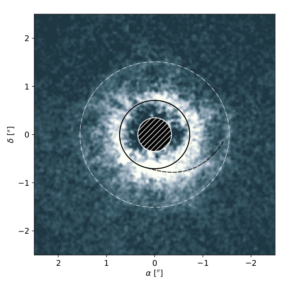Johan Olofsson led a publication using new and deep observations of a debris disks around a low-mass star and detected some unique features that remains challenging to explain.
Debris disk around low-mass stars are difficult to observe due to their faintness, and therefore little is known about them. However, an international team of astronomers, led by Johan Oloffson, associate researcher at Millenium Nucleus for Planet Formation, characterized the disk around a cold dwarf star, putting stingent constraints on the presence of giant planets. The international collaboration included Amelia Bayo, NPF director; Matthias Schereiber, subdirector; Claudio Cáceres, adjunct researcher and Nicolás Godoy, PhD student at Universidad de Valparaíso and NPF.
The central star is TWA7, a young star located at about 110 light years from us. The observations were performed using was the SPHERE instrument, installed at Very Large Telescope (VLT) of the European Southern Observatory, located in Cerro Paranal, Atacama desert, Chile.
Even though this is not the first time that the disk around TWA7 has been imaged, this research allowed to better constrain its properties. “Direct imaging of a debris disk around a low-mass star is important because these low-mass stars behave differently compared to more massive stars, for example, one can see the impact of stellar winds on the disk”, explains Johan Olofsson, who is also researcher at Instituto de Física y Astronomía of Universidad de Valparaíso and director of Max Planck Tandem Group (agreement between Max Planck Institute for Astronomy in Heidelberg, Germany, and Universidad de Valparaíso).
Observations allowed to resolve the main disk around TWA7, which appears very extended in the radial direction, which surprised to researchers. In addition, they detected a very faint outer ring as well as a faint spiral arm. “This is something really unexpected in a debris disk. Spiral arms have been detected in other disks but these disks are much younger and there is a lot of gas. When you have gas, there are several ways to explain spiral arms. But there is no gas, as far as we know, in the disk around TWA7. So it was really a surprise to see this”, astronomer says.

These results could be explained, according to Olofsson, by the presence of a planet with a mass comparable to the mass of the debris disk, which could be causing spiral arm and the outer secondary ring. “This conclusion was supported by numerical simulations presented in another research and, at this moment, it is the best explanation we have for our new observations”, clarifies the researcher.
“Our observations are very sensitive to detect giant gaseous planets but we did not detect any. We can place upper limits of about 0.5 times the mass of Jupiter, which is extremely good. There could be less massive planets but we cannot know about them with our observations”, he adds.
Future work
Olofsson says that the next step is to confirm their findings through deeper observations, using James Webb Space Telescope for instance, a spacial telescope that will be launched in 2020 and will have a mirror with 6.5 meters of diameter. “We cannot do it with SPHERE. We observed TWA7 for about 2hours and we would not gain a lot by observing for 3-4 hours. I think the natural next step would be The James Webb Space Telescope and we will do our best to obtain observing time on that target”, he concludes.
Furthermore, several NPF researchers are actively working with ALMA Observatory data for the same object.
You can read the publication here.
Image, by Oloffson, has some annotations to see where the outer ring and the spiral arm is.